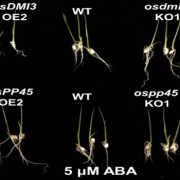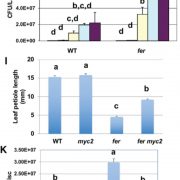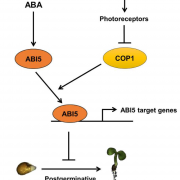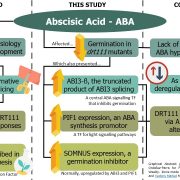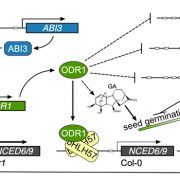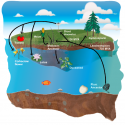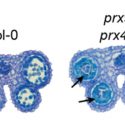Ethylene and ABA Regulate Ascorbic Acid and Reactive Oxygen Species
The phytohormones ethylene and abscisic acid (ABA) often interact in controlling plant growth and development processes as well as plant responses to stress. The detailed mechanisms underlying the interaction of these two phytohormones, which may act synergistically or antagonistically with each other, is not well understood, especially in regard to the regulation of reactive oxygen species (ROS) production and accumulation. The key transcription factors involved in ethylene and ABA signaling, ETHYLENE-INSENSITIVE3 (EIN3) and ABA-INSENSITIVE4 (ABI4), are required to transcriptionally activate the ascorbic acid biosynthesis gene VITAMIN C DEFECTIVE2 (VTC2). Therefore, Yu et al. (10.1104/pp.18.01250) have focused their attention on the role of the EIN3-ABI4-VTC2 cascade in coordinating cross talk between ethylene and ABA in ascorbic acid biosynthesis and ROS accumulation. The authors report that ABA promotes the accumulation of ROS in Arabidopsis thaliana seedlings while ethylene has the opposite effect. Furthermore, changes in the biosynthes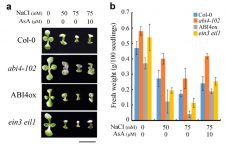 is of ascorbic acid, a powerful anti-oxidant, integrate the interactions of ethylene and ABA in regulating ROS levels. Evidence is presented that ethylene and ABA antagonistically regulate ascorbic acid biosynthesis via EIN3 and ABI4. In addition, ABI4 is transcriptionally repressed by EIN3 during ethylene-regulated ascorbic acid biosynthesis. By means of transcriptome analysis and molecular and genetic experiments, the authors have identified VTC2 as the direct target of ABI4 in the regulation of ascorbic acid biosynthesis and ROS accumulation. Thus, the EIN3-ABI4-VTC2 transcriptional cascade plays a key role in the mechanism by which ethylene and ABA antagonistically regulate ascorbic acid biosynthesis and ROS accumulation in plants in response to complex environmental stimuli.
is of ascorbic acid, a powerful anti-oxidant, integrate the interactions of ethylene and ABA in regulating ROS levels. Evidence is presented that ethylene and ABA antagonistically regulate ascorbic acid biosynthesis via EIN3 and ABI4. In addition, ABI4 is transcriptionally repressed by EIN3 during ethylene-regulated ascorbic acid biosynthesis. By means of transcriptome analysis and molecular and genetic experiments, the authors have identified VTC2 as the direct target of ABI4 in the regulation of ascorbic acid biosynthesis and ROS accumulation. Thus, the EIN3-ABI4-VTC2 transcriptional cascade plays a key role in the mechanism by which ethylene and ABA antagonistically regulate ascorbic acid biosynthesis and ROS accumulation in plants in response to complex environmental stimuli.
The phytohormones ethylene and abscisic acid (ABA) often interact in controlling plant growth and development processes as well as plant responses to stress. The detailed mechanisms underlying the interaction of these two phytohormones, which may act synergistically or antagonistically with each other, is not well understood, especially in regard to the regulation of reactive oxygen species (ROS) production and accumulation. The key transcription factors involved in ethylene and ABA signaling, ETHYLENE-INSENSITIVE3 (EIN3) and ABA-INSENSITIVE4 (ABI4), are required to transcriptionally activate the ascorbic acid biosynthesis gene VITAMIN C DEFECTIVE2 (VTC2). Therefore, Yu et al. (10.1104/pp.18.01250) have focused their attention on the role of the EIN3-ABI4-VTC2 cascade in coordinating cross talk between ethylene and ABA in ascorbic acid biosynthesis and ROS accumulation. The authors report that ABA promotes the accumulation of ROS in Arabidopsis thaliana seedlings while ethylene has the opposite effect. Furthermore, changes in the biosynthesis of ascorbic acid, a powerful anti-oxidant, integrate the interactions of ethylene and ABA in regulating ROS levels. Evidence is presented that ethylene and ABA antagonistically regulate ascorbic acid biosynthesis via EIN3 and ABI4. In addition, ABI4 is transcriptionally repressed by EIN3 during ethylene-regulated ascorbic acid biosynthesis. By means of transcriptome analysis and molecular and genetic experiments, the authors have identified VTC2 as the direct target of ABI4 in the regulation of ascorbic acid biosynthesis and ROS accumulation. Thus, the EIN3-ABI4-VTC2 transcriptional cascade plays a key role in the mechanism by which ethylene and ABA antagonistically regulate ascorbic acid biosynthesis and ROS accumulation in plants in response to complex environmental stimuli.


